Summer may be over, but head to the American South and you’ll find great places to camp deep into the fall months. From Florida to South Carolina, campgrounds have fewer crowds and plenty of space to set up a camp chair, light a campfire, and enjoy the fall season at a different pace than in the summer months. The South is a great place to explore, and the scenery in state and national parks is a unique experience unto itself. These seven spots might just convince you to make fall camping down south an annual tradition.
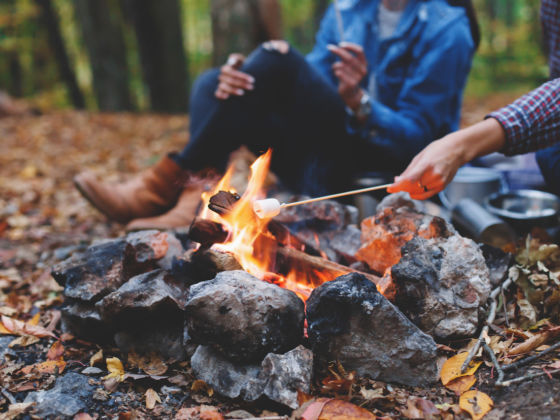
The Best Places to Go Camping in the South This Fall
1. Ocala National Forest — Florida

Photo: Adventures On Wheels/Shutterstock
Ocala National Forest, north of Orlando, might be inland from Florida’s coasts, but water is still very much part of the experience here. Streams and lakes abound in the forest, and several springs — including Juniper Springs and Alexander Springs Creek — make this vast area of pine forests, live oak groves, grasslands, and swamps one of the most popular national forests in the country. That’s all the more reason to enjoy it after the summer crowds depart; with the mild Florida temperatures, you can even enjoy straight through winter.
The 67-mile National Florida Scenic Trail bisects the park, but you can hike along plenty of shorter loops and offshoot trails, as well. You’ll find extensive mountain-biking opportunities, but the real draw here is the water. Canoe or kayak down the springs; the seven-mile Juniper Springs Run is ranked as one of the best runs in the nation. You can also cool off in the lakes and snorkel in the clear water.
You have multiple campgrounds to choose from. Juniper Springs Recreation and Campground, located inside the Ocala National Forest, has 78 campsites, plus hiking trails and a historic millhouse. Campsites are $22 per night, reservable here. Each campsite is equipped with a picnic table, fire ring, grill, and lantern post. Campsites can accommodate motorhomes, trailers, and tents. Restrooms with hot showers are available.
2. Fall Creek Falls State Park — Tennessee
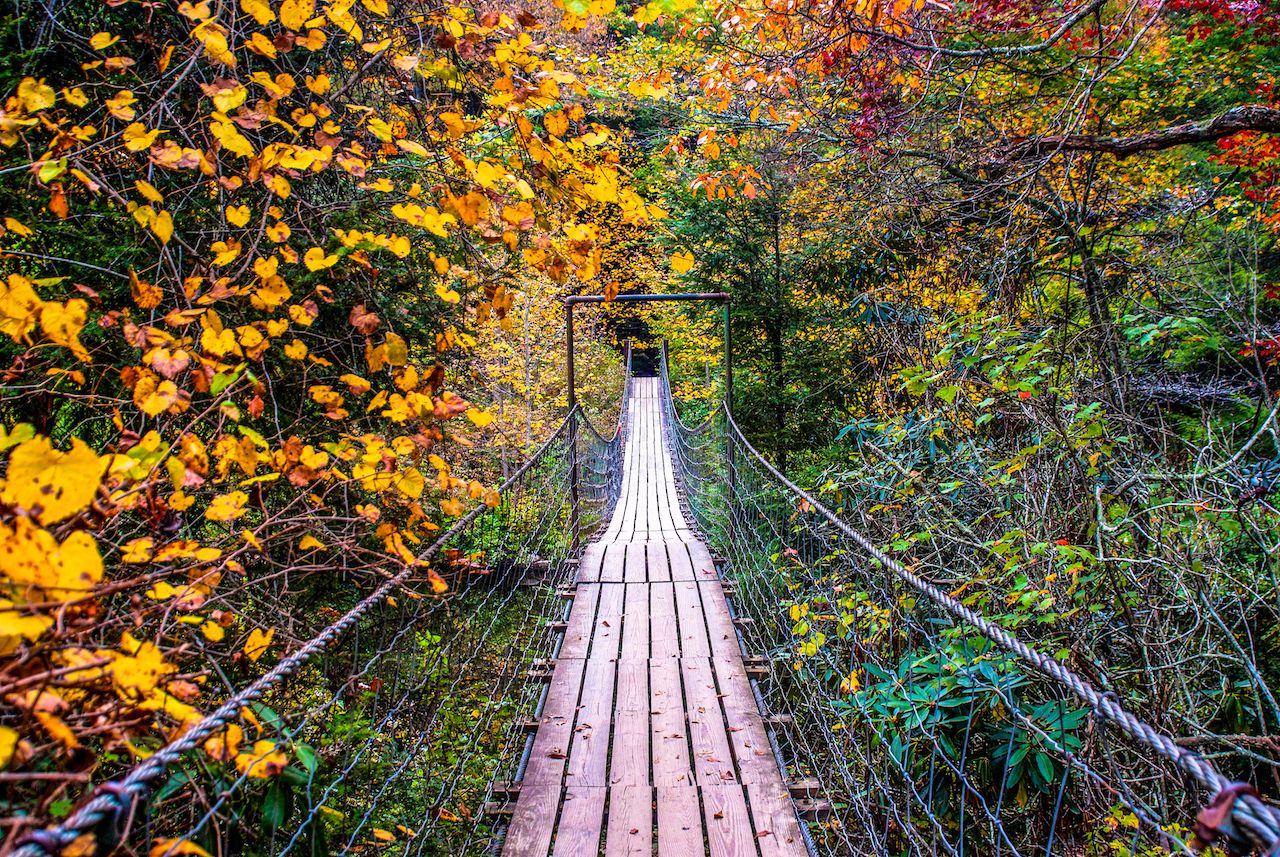
Photo: Maxine Livingston/Shutterstock
Fall Creek Falls State Park spreads across more than 26,000 acres on the eastern tip of the Cumberland Plateau, has 56 miles of trails of incredibly diverse forest — oak, beech, poplar, and hemlock are just some of the species that flourish here. The variety of trees makes for stellar fall hues of brilliant crimson, burnt orange, and golden leaves.
Adding to the beauty at any time of year are streams, gorges, cascades, and waterfalls, including the park’s namesake Fall Creek Falls. At 256 feet, it’s the tallest waterfall in the eastern US. In addition to Fall Creek Falls, others worth checking out include Piney Falls, Cane Creek Falls, and Cane Creek Cascades. Besides the falls and miles of trails, the park has a Canopy Adventure Course with wobbly bridges, rope swings, zip lines, and other challenges that are a fun way to spend a couple of hours.
The largest park in the state also has 222 campsites in five different areas. Consider backcountry camping at one of the 16 campsites located in four different areas along the overnight backpacking trails. You can purchase groceries at the camp store or buy prepared food at the snack bar. There’s even a coin laundry facility, open year-round. Rates are $8 to $35 per night, and you can reserve here.
3. Cloudland Canyon State Park — Georgia
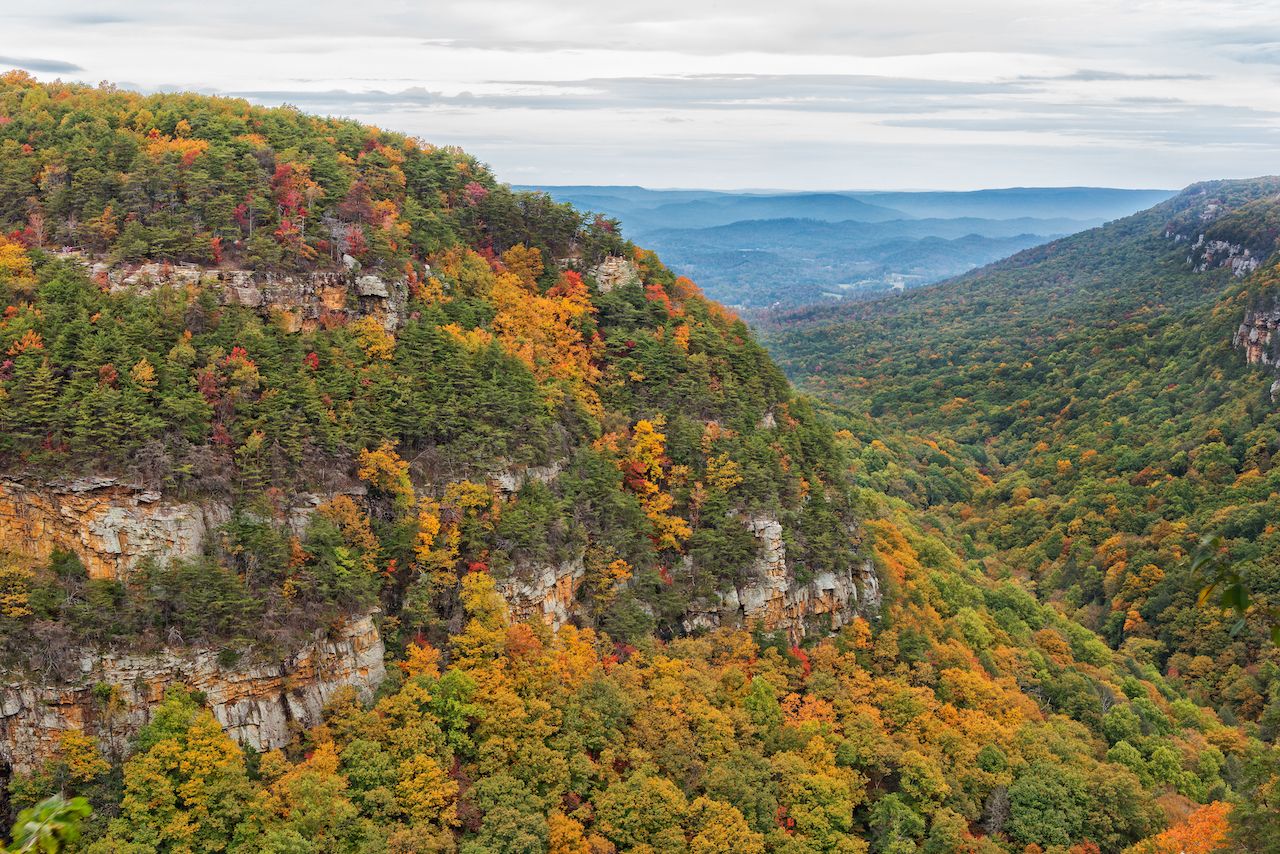
Photo: Jim Vallee/Shutterstock
The 3,500-acre Cloudland Canyon State Park is one of the loveliest state parks in Georgia, with deep gorges, cliffs, and crazy rock formations. It has 64 miles of hiking trails through lush forests, along with streams, waterfalls, cascades, and panoramic overlooks. The most strenuous of the treks include a 1,000-foot elevation gain. For mountain bikers, 30 miles of paths include plenty of intense single-track trails.
The park also has several caves, open through October, that can be explored with permits or on a tour. Fishing, horse riding, and even disc golf are other options here. The park has 72 campsites with a combination of RV, tent, and backcountry options that you can reserve. If you want the camping experience with a little less dirt, the park also has several cottages and yurts you can book.
4. Uwharrie National Forest — North Carolina

Photo: digidreamgrafix/Shutterstock
If you think you’ve missed your opportunity to leaf peep when October ends, head to Uwharrie National Forest, where the fall color extends well into mid-November and often through Thanksgiving. Enter through the Birkhead Wilderness Area and access 5,160 acres of land ripe for exploring. The Uwharrie Mountains have the distinction of being possibly the oldest mountain range in America — more than 500 million years old. Scientists believe that the area was once a chain of huge volcanic peaks reaching 20,000 feet high.
Nowadays, the tallest peaks in the chain rise barely more than a 1,000 feet. Their attraction lies instead in the forests of hardwoods and pines, small lakes, and the Uwharrie River. The forest’s largest lake, the 5,350-acre Badin Lake, lies on the northwest corner of the park and is excellent for fishing, swimming, and boating. Beyond that, hiking, horseback riding, and four-wheel driving all are popular pastimes.
You don’t expect to find a mountain range in the middle of the state, but it’s there — and surprisingly pristine as the area only allows hiking and tent camping. Camping is year-round, and all sites have graveled tent pads, fire rings, and a light hook. For primitive camping, check out West Morris Mountain, Woodrun Trailhead, and Yates Place. Reserve here.
5. Pilot Mountain State Park — North Carolina

Photo: Xian Zhang/Shutterstock
Pilot Mountain, a National Natural Landmark, seems to rise out of nowhere in the rolling foothills near the Blue Ridge Mountains — reaching 1,400 above the valley floor. Modern travelers find it as useful for navigation as the Saura Indians did centuries ago, hence the “pilot” name. Even more unusual than its height relative to the neighboring landscape is the quartzite “knob” at the top of it, which looks like a little cupcake set atop the mountain with a forest for frosting.
Beyond ascending Pilot Mountain, you can rock climb, rappel, horseback ride, paddle the Yadkin River, and hike on everything from easy to strenuous trails. The park has 49 campsites for tents and trailers; some can accommodate RVs without hookups or a dump station. The south bank of the river offers primitive paddle-in campsites. Sites are open from March 15 to November 30. Each site has a tent pad, table, and fire pit with a grill. Drinking water and hot showers are available. You can reserve here.
6. South Cumberland State Park — Tennessee
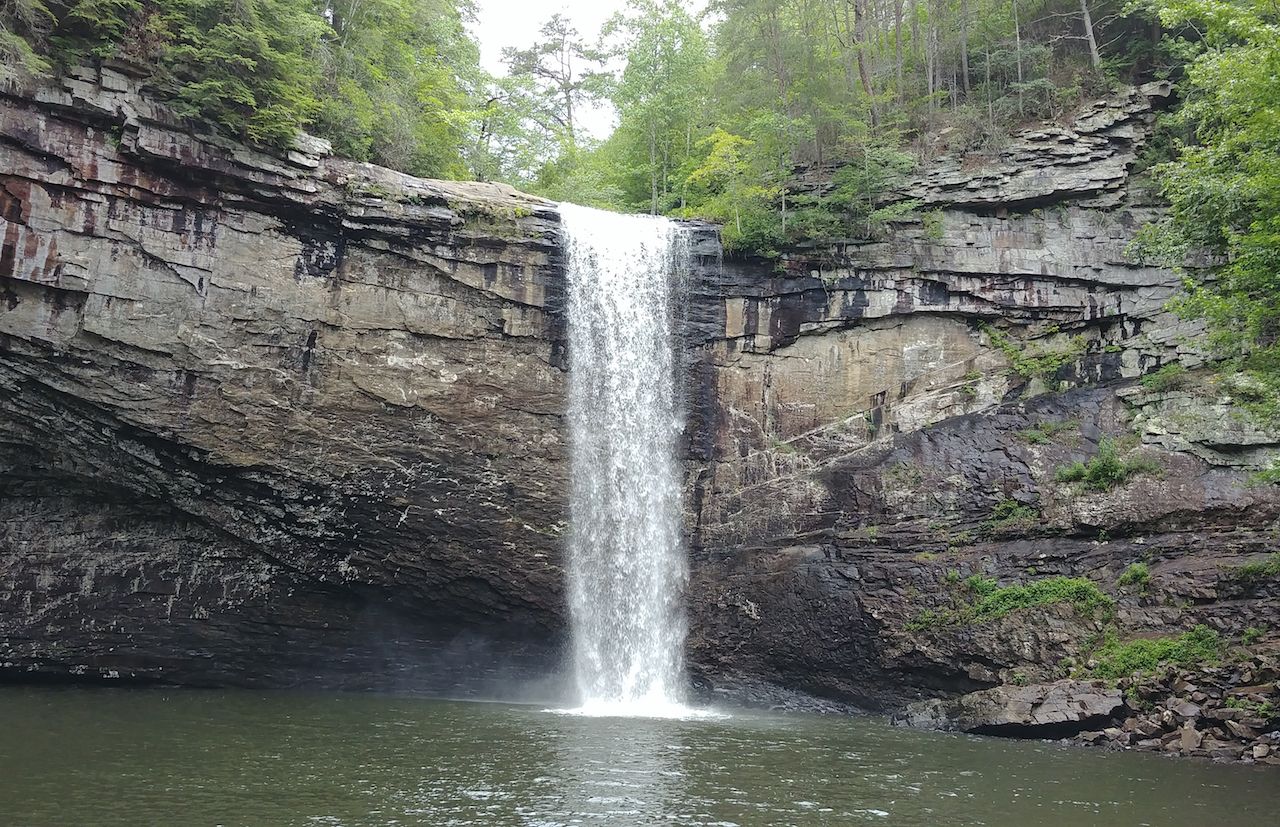
Photo: dansif/Shutterstock
South Cumberland State Park has over 90 miles of trails where you’ll discover waterfalls, wildflowers, vistas, and historical areas. Besides hiking and backpacking, the park is well known for its rock-climbing routes. Spots like the gorge near Foster Falls have both sport and traditional routes while Denny Cove has over 150 routes. The Stone Door is a big rocky ledge above the lush forest. Registration for all rock climbing is required.
If you prefer, you can hike to the Stone Door and places like Foster Falls. The park also offers multiple programs throughout the year, including interpretive walks, canoeing, introductory rock climbing, animal shows, instructional classes, stargazing, creek critter surveys, and more.
Ninety-three campsites (and one rustic lodge, the Hobbs Cabin) are located within 12 backcountry campgrounds across the Fiery Gizzard and Savage Gulf trail systems within South Cumberland State Park. Rates are $8-$45 per night. The Foster Falls campground has 26 rustic campsites ideal for tents or small trailers. Reservations are required for Foster Falls and backcountry camping. The campground is open year-round.
7. Sam Houston Jones State Park — Louisiana
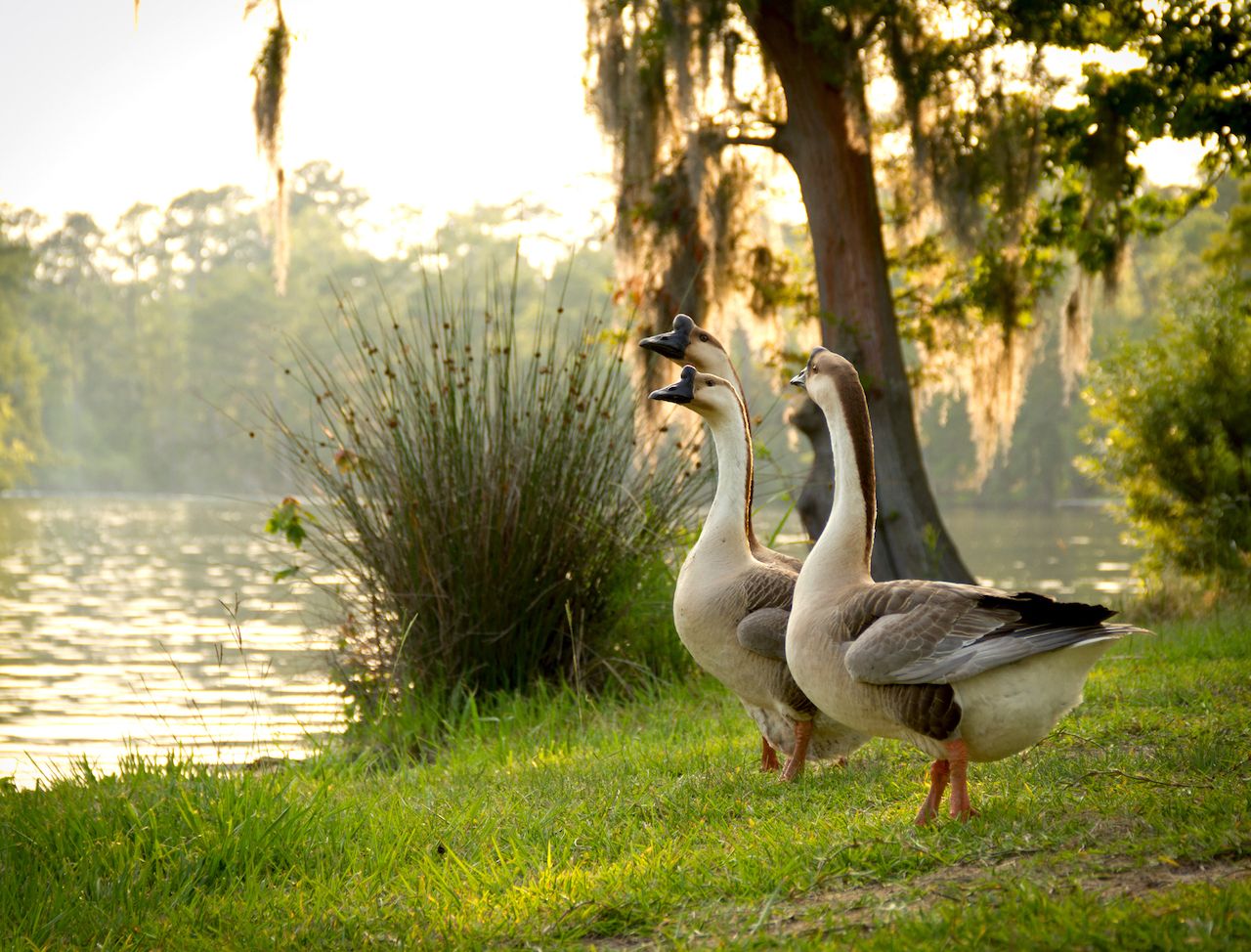
Photo: Meg McFarlain/Shutterstock
Sam Houston Jones State Park, off Highway 378 in Moss Bluff, Louisiana, features 1,087 acres of lakes, trees, vistas, rivers and streams, nature trails, biking trails, and campgrounds. The tree-filled lagoons are a unique natural environment for many animals. It’s an excellent spot for bird watching with nearly 20 species brought in by migratory patterns in the spring and fall. And with the numerous waterways, water sports are a high spot at the park. Two boat launches located on the West Fork of the Calcasieu River provide access to the Gulf of Mexico only a few miles away.
Also, the three hiking trails through pine and hardwood forests make for some good strolling or serious hiking. On the old stagecoach road, hikers can travel to explore the park and the banks of the various tributaries to the Calcasieu River. This tract of land can be enjoyed for both day-use and overnight visitors. The park is also excellent for bird watching with nearly 200 species visible nearby, so be sure and bring binoculars.
The park has vacation cabins, campsites, and tent sites. The non-peak season runs from October 1 to March 31, when a premium campsite runs $25 to $33 per night. A standard cabin is $85. Reservations must be made one day ahead of arrival and can be made up to 13 months in advance.